Daphne wrote this history of Bowers House based on her detailed transciption of wills, inventories, censuses and other sources studied by the WEA classes with Lionel Munby from 1970-73, and from classes in in vernacular architecture with Tony Baggs in 1975. It had been edited, to omit some detail about owners and occupiers, but these have now (February 2017) been added. Biographies of Dr Spackman and Dr Blake have been published as separate pages. Further notes have been added, and there is a sequence of photos and paintings at the foot of this page.
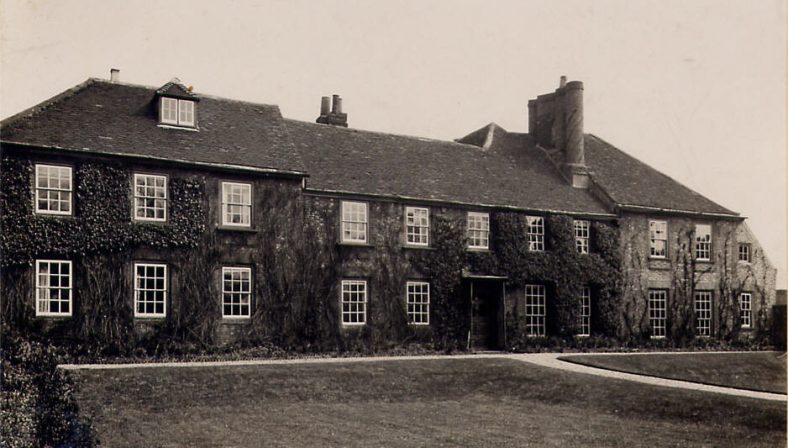
Bowers House, from the 1935 sales catalogue
This lovely old house which for several hundred years must have been one of the most attractive and prominent features of the village and familiar to all, is now sadly hidden away behind the shops and known to only a few. It doesn’t seem to have changed its name over the years but has always been called Bowers. Where Carlton Road meets Sun Lane, there used to be Bowers Hall Farm (later known as Starvegut Hall when it was in a very run-down condition) and it seems possible that the two were associated and took their names from a John atte Boure, who bought a messuage and half a carucate of land from John Coter the younger, in 1391. From him this holding passed to Roger Bower, and in 1528 it was held by William Cressy and later by Edward Brocket. Some of the Brocket property came to the Bardolphs and may have included Bowers.
Origins of the present house
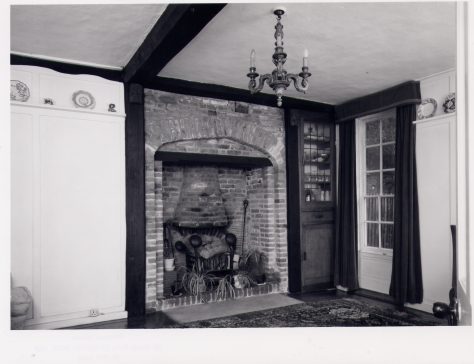
Bowers House, dining room stripped of panelling – LHS archives – copyright RCHM 1975
The present house contains traces of the timber framed building that was erected in the early 16th century. From the beginning it was a two-storied house with perhaps a central hall, the parlour on the southern side and the service end to the north. There are carpenters’ marks still visible on timbers in the wall of the northern end, which has suffered a number of changes. In the present kitchen, there is an old outside wall post, which lines up with the wall between the hall and parlour and in it are some peg holes which our tutor Mr Baggs tells us indicate the position of a window. The room which we think was the parlour still has oak panelling and large square wall plates at floor level, which formed the base of the timber framing.
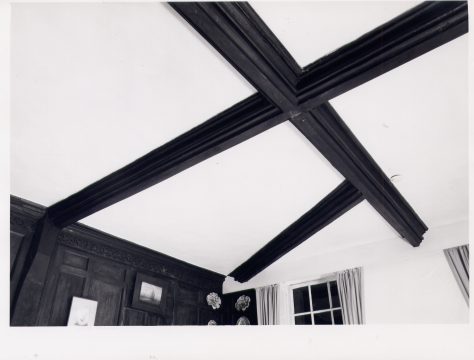
Bowers House – Dragon beam in SW crosswing – LHS archives – copyright RCHM 1975
This part of the building was jettied on two sides and the moulded dragon beam remains still to be seen in the ceiling of the parlour. This room has a 17th century overmantel with carved panels and moulded balusters. The front of the house was bricked up in the late 17th century and this was followed by alterations to the interior.
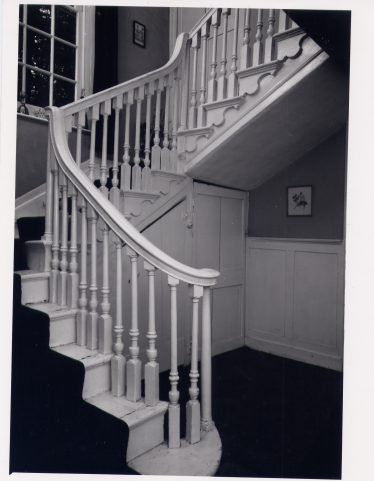
Bowers House – C18 staircase – LHS archives – copyright RCHM 1975
A staircase was added in the mid 18th century and a corridor was made at the back of the house both upstairs and down.
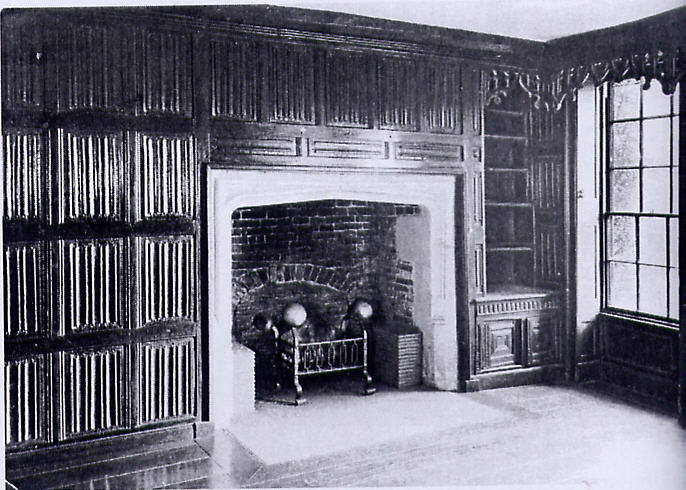
Bowers House – dining room with panelling, c.1935 – Reproduced from Ralph Webster: It Started with a Green Line Bus
The Royal Commission on Historical Monuments in 1908 stated that ‘a room south of the entrance (the present dining room) has early 16th century linen-fold paneling and a fireplace with moulded stone jambs and a four center head’, but these were taken from the house and sold in the 1930s.
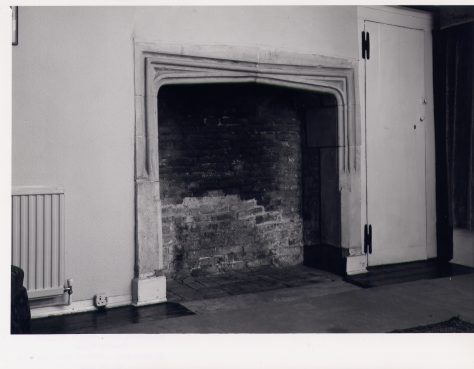
Bowers House – Tudor stone fireplace, with various carved initials – LHS archives – copyright RCHM 1975
A Tudor fireplace remains in the room above, which appears to have been a children’s room at some time because several sets of initials have been scratched on the jambs. There is an E.H. with the date 1725 alongside, and another E.H. with either 1726 or 1720; also E.H., H.R., T.S. and S.S. On top of the arch is a large letter ‘B’ which looks very much the same as the ‘B’ which was the mark of Jonas Bray, although one would not expect a man of his standing to deface the fireplace.
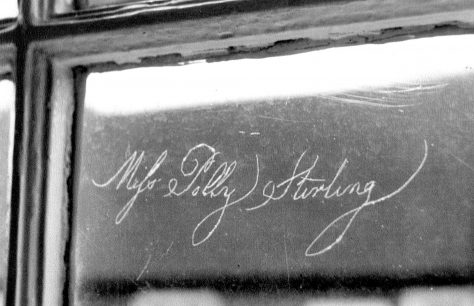
Engraving on west-facing bedroom window – Eric Meadows – 143/45
On one of the panes of a bedroom window, the words ‘Mifs Polly Stirling’ have been engraved. It could only have been done with a diamond. The copper-plate writing is very neat, but the author remains anonymous.
Early occupants
Richard Bardolph, brother of Edmund Bardolf of Rothamsted, was living at Bowers in 1597 and in 1614 Edward Bardolph sold the house to Richard, with 8 acres of land adjoining the orchard of the house, west of Thompsons Close (a field at the time); another 13 acres called Nichlas, which was beside Heylane (between Amenbury Lane and the church); also some other small pieces of land. However the sale did not include the seats in the church or the path through Nichlas Close. Richard Bardolf married Grace Mune (Muns or Munt) in 1579 and there were five children alive when he died in 1623. He left Bowers to his son Richard, conditional upon his fulfilling various instructions regarding his other legacies. His wife Grace was to have all his moveable goods with the exception of his best bedstead and the Press in the hall; she was given all the wood in the yard, and Richard wishes her to have and enjoy all her wearing apparell (sic). He wanted her “to have, hold, occupy and possess all these Roomes and houses whatsoever which I do not use and occupy, together with the yarde and orchard and garden …” He bequeathed £110 to Grace as well. Other bequests were made to another son, three daughters and seven grandsons.
There is quite a detailed inventory which gives a comprehensive picture of Bowers in 1623. The contents of the hall and parlour are listed, as well as the things in the “studie, kitchen, boulting house, buttery, cellar, chamber over the hall, chamber over the parlour, a long chamber and the room over the stairs head”.
There is a document dated 1630 in which Grace sells her interest in Bowers to Richard Bardolph, Innholder, of Romford, and this seems to be her son, who inherited Bowers from his father. The house fairly soon came into the possession of Jane, the daughter of Richard and granddaughter of Grace, and wife of John Allen, of Wimbish, Essex. In 1650 John and Jane Allen sold Bowers to Sir John Wittewronge for £360. So it returned to the Rothamsted Estate and remained in the hands of the lords of the manor for nearly three hundred years until, in 1912 Bowers House was sold to Dr Blake, who lived there until his death in 1933.
Bowers as part of marriage settlements
From time to time, Bowers formed part of the settlement made when an heir of the manorial family was married. The first occasion was in 1667 when Sir John Wittewronge’s son James married Elizabeth Diconson. We are then told that the messuage and 11.5 acres were in the tenure of Jonas Bray (from the 1660s to c.1690).
Jonas Bray married Mary Wiltshire during the Protectorate, so their marriage ceremony took place before John King Esq, one of the Justices of the Peace for Hertfordshire on 29 September 1655, “in the presence of Jonas Cotton, Andrew Bray and John Squire”. They had a family of two boys and two girls. There is nothing to say when Jonas took up residence at Bowers or how he came to own Yew Tree Farm. In the Hearth Tax return for 1663, Jonas was taxed for 5 hearths, which would appear to refer to Bowers. He served the community as Overseer (of the Poor) on five occasions and three times was a Churchwarden. His large mark, the letter ‘B’ is often found as he witnessed other people’s wills and praised their goods for inventories. Godman Jenkyn described him as “my good friend” and left twenty shillings to buy him a “mourning ring”.
When he made his own will in 1689, Jonas described himself as a “yeoman being aged but of sound and perfect memory”. He bequeathed his copyhold land and appurtenances (ie Bowers) to his eldest son Joseph, together with yew Tree Farm and all his other freehold lands with the exception of Barnes Dene Close, and Dennis Croft and 3 roods of arable land in Manland Common, which were left to his other son, also called Jonas. his wife Mary was to receive an annuity of £5 paid by Joseph, and to have his household goods. There is an inventory with his will, but it does not list the contents of the house, it only gives his farm stock. It is quite a short list, with a total of £176, of this £80 was the value of the wheat in the barn and wheat in the ground, and his only equipment was two old carts and two old ploughs and harrows.
Two years after the death of Jonas Bray, Bowers was again mentioned in a marriage settlement, this time that of Jacob Wittewronge and Elizabeth Cogghill; and dated that same year, 1692, there is an account of the work done and money paid for repairs at the house. The bill tells us how much the sawyers were paid for the “rending of hartlath and saplath” and for the “slitwork for rafters”. Mr Crossly was paid 1/- (5 pence) for 2 loads of sand and 3/- (15 pence) for gathering 9 sacks of moss. The largest expenditure was £2 8/- to henry Staker for 2,000 bricks and 5 quarters of lyme and 10/- for 80 “guttertyles”/ The total bill was £10.8s.2d. So it seems that before the end of the 17th century Bowers had a tiled roof in place of its original thatch. on 16 july 1693 there is a record of Joseph Bray having paid, in part, his lady day rent, showing that he was still the tenant, if not for much longer.
Jacob Wittewronge, who was only 22 and not long married, died that same year (1693). His son Jacob was born postumously and Elizabeth Wittewronge married Anthony Ettrick. Jacob married his cousin Ann Hale in 1721 and the marriage settlement on this occasion stated that Bowers was then in jointure to Elizabeth Ettrick. his mother. The Poor Rate of 1735 tells us that mrs Ettrick was still there and that a John Kerk also paid a rate for his part of Bowers land.
In another settlement of 1745, when James Wittewronge and Martha Strange were married, we find that Mrs Ettrick had been widowed again and that the Reverend George barnard is the tenant. He seems to have been there since 1744 although he had a house of his own in Harpenden (Bennetts) which was standing empty.
Let to curates of St Nicholas Church
George Barnard was the son of Captain Geo. Barnard of St Giles in the Fields, Middlesex. He was educated at St Mary Hall, Oxford, and Emanuel College, Cambridge. After a curacy at Bushey, he came to Harpenden as curate in 1716. He lived in Bowers for only a short time between 1744 and 1746. Perhaps his own house was being altered or repaired. he had been appointed Rector of Knebworth in 1737 and in 1745 Vicar of Luton, in which year he resigned as curate of Harpenden. Barnard died in 1760 and was buried in Harpenden churchyard. In the parish records are a few pages of a notebook in which he kept a record of his perquisites and this is quite an illuminating little document.
Between July and November 1747 the windows of the house received a good deal of attention. There is an account of all the glass and lead used. Some new glass was put in (Crown sack squares and lesser sack squares) and old glass was replaced, releaded and soldered. New lead for the ‘systern’ (cistern) weighed 603 lbs (550kg) and the solder 37 lbs. The lead cost £5.12.6. and the solder £1.10.0.
For nine years after this, the occupant was the Rev. Benjamin Preedy. This was the curate who was given permission to build a gallery at the steeple end of the church, at his own expense and for the use of his family, but he did not carry this out. He was elected Rector of St Albans and also Master of the Free Grammar School at a salary of £22.13.4. a post he held despite there apparently being no scholars to teach. He resigned the Mastership of the Free School in August 1775 and his son James was elected in his place. A few months later Benjamin Preedy resigned the Rectorship of St Peters (in St Albans), and less than a year after his appointment, James resigned the Mastership of the Grammar School – in 1778 he became curate of Harpenden.
According to the Rate Book, the next tenant of Bowers was a Henry Trollope Esq., but I know nothing about him at all. Then in 1764 a Mr Robert Wetherall was there, and all I know about him is that he had been a merchant at Port Royal, Jamaica. After Wetherall came a Madam Skey, then a Mr Fox and a John Hook. These names were taken from the Land Tax Returns and it may be that they only rented the land and did not occupy the house.
But in 1801 the tenant of Bowers was Mary Wheeldon. Mary was the niece of Dr Green, Bishop of Lincoln, and was the widow of the Rev John Wheeldon, Rector of Wheathampstead, who had died the previous year. Their son John was the curate of Harpenden at this time, and Mary died at St Albans in 1820, aged 69. In 1803, Sir Thomas Durrant, who came from Scottow, in Norfolk, lived at Bowers for a few years with his wife Sarah and their family. In the church registers the baptisms of two children are recorded: a daughter Emily Mary in 1803 and in 1807 a son, Thomas Henry who later became Sir Henry Durrant, 3rd baronet.
None of these last six occupants lived at Bowers for very long, and it seems that the Rothamsted family were able to offer it to members of the upper social strata who needed a temporary home.
The Durrants were succeeded by the Rev David George Knox, who on 25th June 1810 was married at Harpenden to Miss Marianne Sherman, daughter of Margaret Johnstone, who was descended from the Earls of Annandale, and of John C Sherman of Drayton, Oxon, a retired dancing master. There used to be (maybe still is) an old ‘Hand in Hand’ Fire Insurance mark on the house and this was in respect of a policy taken out by the Rev. Knox for the sum of £1200, on the contents of the house. Unhappily this young man died only a few months after his wedding, and his obituary in The Gentleman’s Magazine reads: “At Harpenden in his 24th year, the Rev. D G Knox BA of Trinity College, Cambridge. The sudden death of this benevolent young gentleman is deeply regretted by all his friends”.
Marianne was still under 21 years of age when, in August 1812, she married John Bennet Lawes of Rothamsted, and ten years later she was widowed again, having had two daughters and one son, who like his father was John Bennett Lawes. Marianne died in 1875 in her 86th year.
From the Tithe Schedule, it would appear that Henry Child was occupying Bowers in 1840 and if he is the same as the man whose monument is in the churchyard, he was for many years Overseer to the Board of Ordnance of the Works at the Tower, and he died in 1848 at the age of 73. The 1851 census shows that James and Eliza Field, who both came from London, lived at Bowers with a staff of one female servant and one male servant, who was groom and gardener. James Field gave his occupation as a merchant of Straw and Fancy Goods.
Arrival of Dr Spackman
After this came a family who were to live in Harpenden for more than fifty years, their home being Bowers for about forty years, and whose influence on the life of the village was very deep. This was the Spackman family who lived at Bowers until 1900. Dr Frederick Robert Spackman was born in 1820, the son of Robert Spackman, a surgeon in Lutterworth, near Leicester. He obtained his licence from the Society of Apothecaries in 1840, membership of the Royal College of Surgeons in 1842, his London M.B. in the same year and his M.D. in 1856. He was consultant physician at St Albans Hospital and in Harpenden took over the practice of Dr Kingston. He served the people of Harpenden and Redbourn until his retirement in 1891.
In 1879 Dr Blake joined him as assistant, and moved with his family to Bowers House following Mrs Spackman’s death in 1900. Dr Blake retired in 1920, and remained at Bowers House with members of his family until his death at the age of 80 in 1933, as the first pedestrian victim of a road accident in Harpenden.
Postscript
Theodora Wilson had commented in her Journals (p.229) in 1933, when Dr Blake died: “the family want to sell the beautiful old house as a private dwelling and no one in Harpenden can bear the thought of its being pulled down and made into shop frontages. Yet it is a valuable site and who in these distressed times can afford a fancy price for an old house more picturesque than salubrious?”
In 1936 Bowers House was bought by H E Webster (founder of H E Webster Limited (Building Contractors) for £800, along with part of the garden and access from the High Street. Ralph Webster in his memoir It Started with a Green Line Bus (2003, pp.47-57) describes the house and his first impressions in 1936, when he got lost on the top floor while his father discussed terms with the estate agent Mr Leslie Gillow of Gillow, Brading and Elm. In his childhood the large bedroom with a large Tudor stone fireplace was used as a sports room, complete with snooker table and punch ball!
The rest of the garden was sold off to C F Putterill (whose garden of ‘Bowers End’ backed on to Bowers House garden), and the front garden was sold, with the permission of Mr Johnson, the then Surveyor for Harpenden Urban District Council, for development of Bowers Parade. No separate planning permission was needed then, and the objections of local people were ignored. H E Webster’s builders’ yard occupied most of the remaining back garden, with a joinery shop in the northern part of the grounds behind what had been Dr Blake’s surgery. This was used as the Salvation Army Forces Canteen in WWII. The southern wing was sold as a maisonette, but two ground floor rooms at the rear were retained as offices. The northern wing was converted into two flats.
We understand the house was sold in separate parts in 1955. The builder’s yard and offices were later occupied by Grimwade (builders) until the remainder of gardens and workshops were cleared for access to the development of The Foresters by Jarvis & Co in 2010-11.
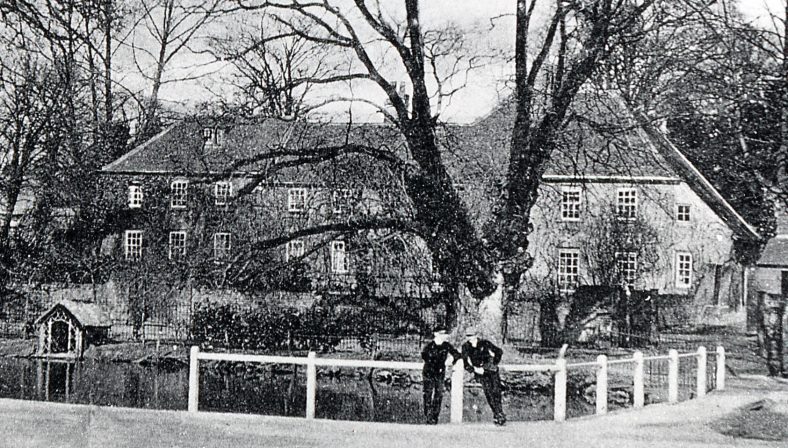
Bowers House, facing the Cock Pond – c.1900 – LHS archives, cat.no.B 1.19
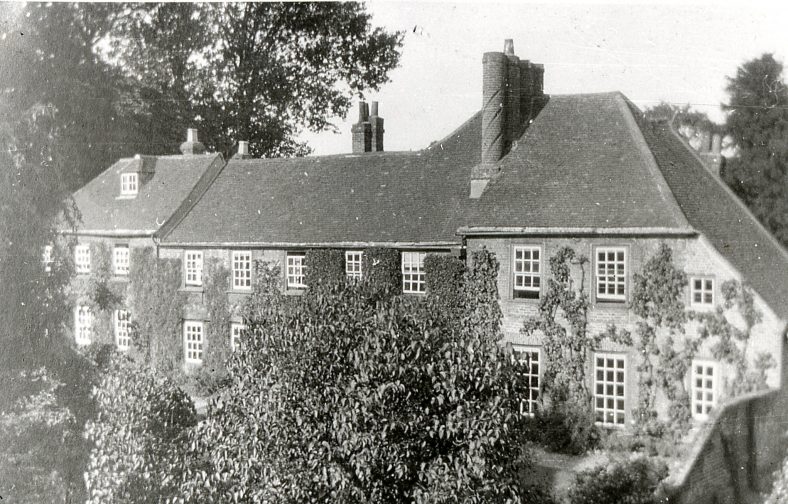
Viewed from the old Music School, c.1920 – LHS archives: B 1.17
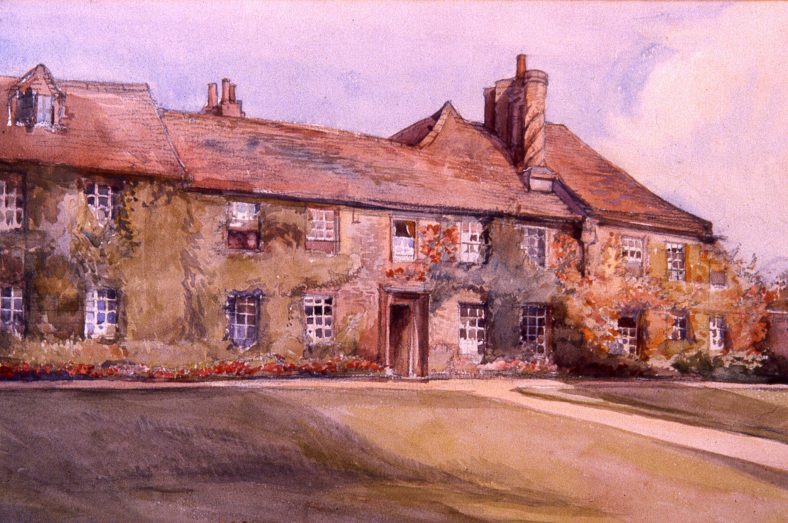
Bowers House, watercolour by J C Allsopp, c.1910 – LHS archives, scan cat.no. B 3.42
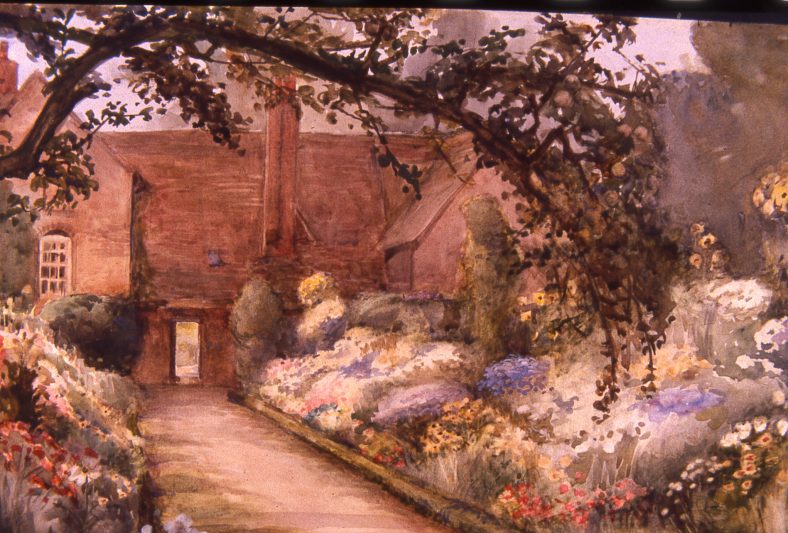
Garden of Bowers House, watercolour by C A Allsopp, c.1910 – LHS archives, scan cat. no. B 3.41
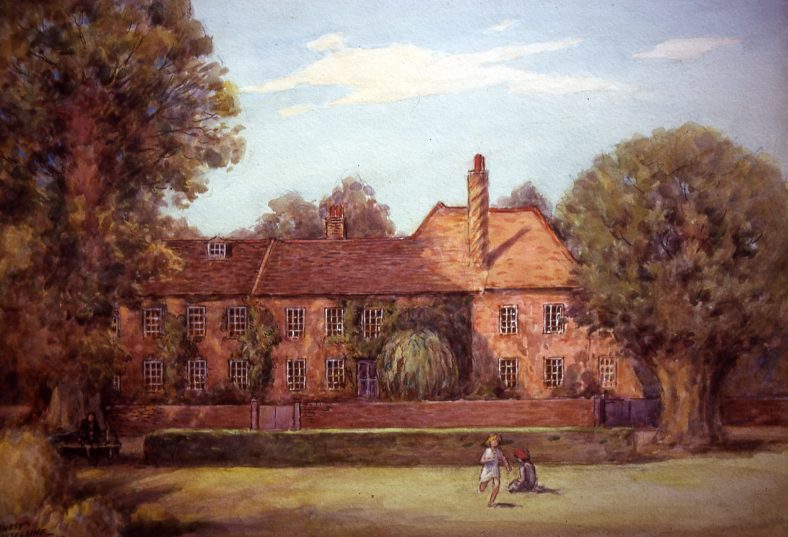
Bowers House, watercolour by E Hasseldine, 1920s – LHS archives, scan cat. B 2.60
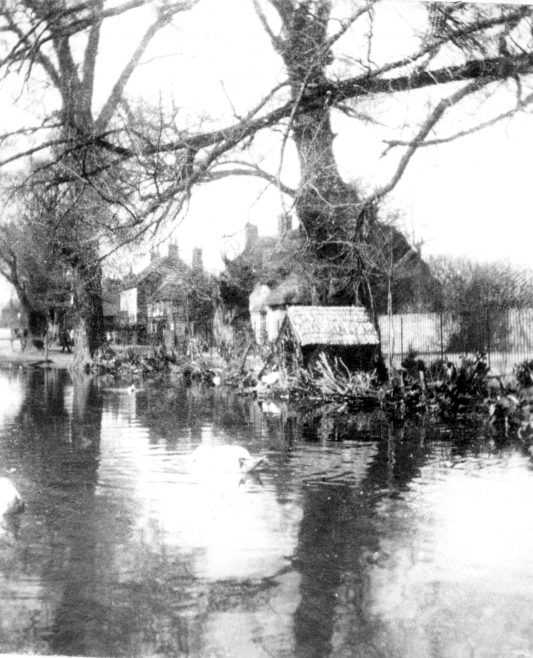
The duckhouse on the Cock pond, in front or Bowers House – LHS archives, scan cat. B 2.60

Rescue of a horse and cart from the Cock Pond – Bowers House behind – 1890s – LHS archives, cat.no. HC 180

No Comments
Add a comment about this page